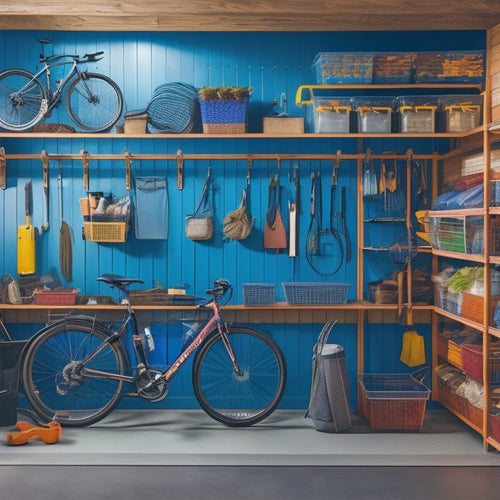
Rev Up Your Ride: Elevate Audio Quality
Share
I'm taking my vehicle's audio system to the next level by tackling the essential step of sound deadening. I've gathered the necessary tools and supplies, organized them for easy access, and meticulously cleaned surfaces for high-quality adhesion. I've removed trim pieces and fasteners, documenting my progress for easy reassembly. Now, I'm ready to apply sound deadening materials like butyl/aluminum sheeting and ensolite foam to reduce ambient noise levels. With a quieter interior environment, I'll be able to fine-tune my audio setup and identify areas needing additional attention for targeted upgrades - and that's just the starting point for a truly immersive driving experience.
Key Takeaways
• Prepare your vehicle for sound deadening by gathering necessary tools, cleaning surfaces, and removing trim and fasteners.
• Apply butyl/aluminum sheeting, ensolite foam, and expanding polyurethane foam to reduce ambient noise levels and improve audio quality.
• Install sound deadening mats in designated spaces, pressing them firmly into place under carpet and panels for optimal results.
• Achieve a quieter interior environment to accurately assess and fine-tune your audio setup with advanced soundproofing techniques.
• Target areas needing additional attention, adding insulation, sealing gaps, and using specialized materials to minimize resonance and vibration.
Preparing for Sound Deadening
Before diving into the auto sound deadening process, I gather the necessary tools and supplies, including tin snips, a ShopVac, and metal tape, to guarantee a smooth and efficient installation.
Next, I organize my tools in a logical order to make sure I've everything within reach. Cleaning surfaces is important, so I meticulously wipe down all areas where the sound deadening materials will be applied. This step is essential for top-notch adhesion and performance.
I also take the time to thoroughly clean any crevices or hard-to-reach areas, ensuring they're free from dirt and debris. By doing so, I set myself up for success and ensure a professional-grade installation that will elevate my car's audio quality.
Removing Trim and Fasteners
I begin by identifying how the internal trim pieces are attached to the vehicle's sheet metal, carefully examining the fasteners that hold them in place. This important step helps me understand the trim's attachment points, allowing me to remove the fasteners safely and efficiently.
I take note of the type and location of each fastener, documenting my progress for easy reference during reassembly. Next, I systematically remove the trim pieces, taking care not to damage them. Fastener removal requires patience and attention to detail, as I gently pry and twist the fasteners loose.
With the trim removed, I'm one step closer to accessing the interior of my vehicle and applying sound deadening materials to elevate my ride's audio quality.
Applying Sound Deadening Materials
With the trim removed, I'm ready to apply the sound deadening materials, starting with the essential butyl/aluminum sheeting to reduce noise levels and improve overall audio quality.
This material is vital for soundproofing benefits, as it effectively absorbs vibrations and minimizes resonance. I carefully clean the surfaces to guarantee a strong adhesive application, then cut the sheeting to fit the specific areas.
Next, I apply the ensolite foam and expanding polyurethane foam to cover empty spaces and cavities, further enhancing the soundproofing effects. By meticulously applying these materials, I can notably reduce ambient noise levels, allowing me to fully enjoy my car's audio system.
The result will be a more immersive and engaging driving experience.
Installing Sound Deadening Mats
Using a utility knife, I carefully cut the sound deadening mat to fit snugly into the designated spaces, guaranteeing a precise installation that will effectively reduce noise and vibration.
Next, I remove the trim pieces to access the interior of the vehicle, taking care not to damage them during the removal process. I clean the surfaces thoroughly to secure better adhesion of the matting.
Then, I press the matting firmly into place, making sure it's securely attached under the carpet and panels. This interior upgrade will notably reduce ambient noise levels, resulting in a more enjoyable driving experience and improved audio quality.
With the sound deadening mats installed, I can already notice the difference – a quieter, more immersive ride that's perfect for music lovers like me.
Enhancing Audio Quality Results
Sound deadening mats installation sets the stage for further audio quality enhancements, as a quieter interior environment allows for a more accurate assessment of the sound system's performance.
With a solid foundation in place, I can now focus on fine-tuning my audio setup. By employing advanced soundproofing techniques, such as acoustic enhancement and noise reduction, I can take my ride's audio to the next level.
I'll start by identifying areas that require additional attention, then apply targeted audio upgrade solutions. This might involve adding insulation, sealing gaps, or incorporating specialized materials to minimize resonance and vibration.
Frequently Asked Questions
Can I Use Sound Deadening Materials on My Car's Exterior?
"I'm considering applying sound deadening materials to my car's exterior, but I wonder if they'll withstand exterior noise and harsh weather conditions; I'll need weather-resistant materials that can handle the elements while reducing exterior noise."
How Long Does the Sound Deadening Process Typically Take?
When sound deadening my car, I factor in time constraints and labor costs, as the process can take several hours to several days, depending on the complexity of the job and my level of expertise.
Are There Any Specific Safety Precautions I Should Take During Installation?
"Did you know 75% of car owners report improved audio quality after sound deadening? When installing, I take precautions against electrical risks from short circuits and physical hazards like sharp edges, ensuring a safe and successful process."
Can I Reuse the Removed Trim Pieces After Sound Deadening Installation?
I carefully inspect the removed trim pieces' condition, storing them safely to prevent damage; if they're in good shape, I can reuse them after sound deadening installation, ensuring a seamless reassembly process.
Will Sound Deadening Materials Affect My Car's Resale Value?
"When it comes to crunch time, I consider the appraisal impact of sound deadening materials on my car's resale value; while some may view it as a drawback, I believe the benefits far outweigh the potential resale concerns."
Related Posts
-

Small Storage Bins to Maximize Shelf Space
When maximizing shelf space, you want to make the most of every inch. Small storage bins are the answer, but choosing...
-

Tool Storage Chests for a More Organized Workspace
You're looking to enhance productivity and reduce stress in your workspace by getting your tools organized, and that'...
-

Garage Wall Storage Ideas to Boost Productivity
You can enhance your garage's productivity by capitalizing on your ceiling height with overhead racks, storing bulky ...


